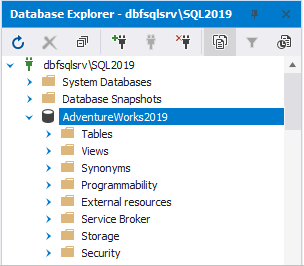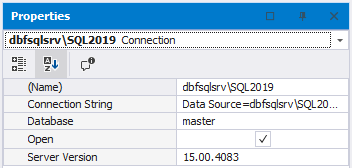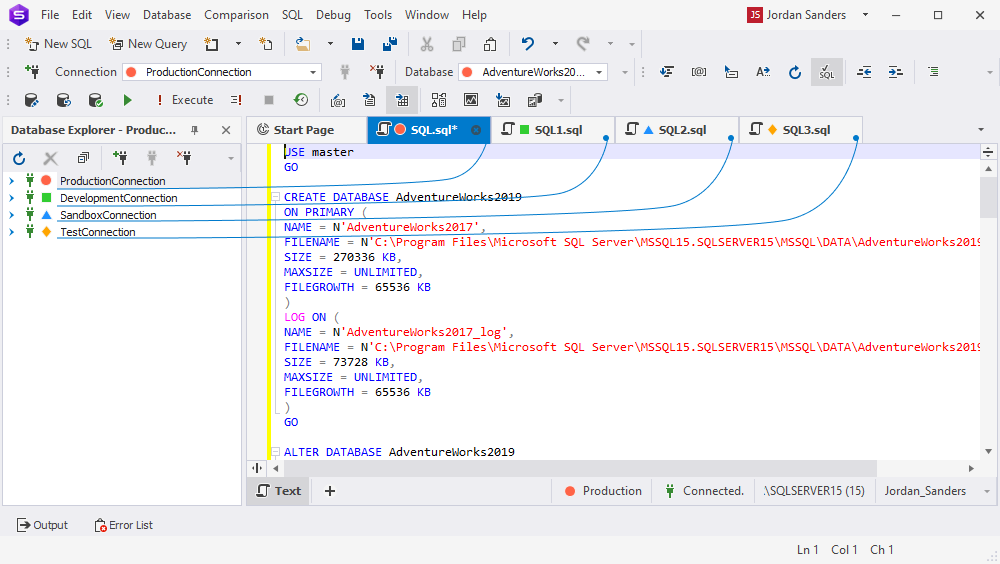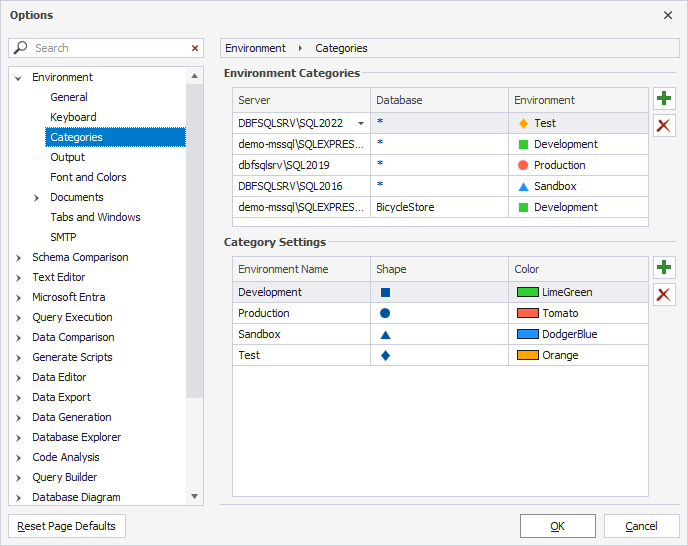Manage database connections
dbForge Studio for SQL Server offers a visual, quick, and simple way to manage database connections from Database Explorer.
Open Database Explorer
By default, Database Explorer opens when you start dbForge Studio. If it is closed, you can open it by doing one of the following:
- Navigate to the View menu and select Database Explorer.
- Press CTRL+W, L.

Database Explorer displays recently used database connections. When opening Database Explorer for the first time, no connections are shown.
Open a database connection
To open a database connection, do one of the following:
-
In Database Explorer, double-click a connection that was closed.
-
In Database Explorer, right-click the closed connection and select Open.
-
On the Database Explorer toolbar, select
 Open Connection for the closed connection selected in Database Explorer.
Open Connection for the closed connection selected in Database Explorer.
In Database Explorer, the connection icon is changed to ![]() , and the connection node displays a list of databases assigned to the connection.
, and the connection node displays a list of databases assigned to the connection.
Close a database connection
To close a database connection, do one of the following:
-
In Database Explorer, right-click the open connection and select Close.
-
On the Database Explorer toolbar, select
 Close Connection for the open connection selected in Database Explorer.
Close Connection for the open connection selected in Database Explorer.
In Database Explorer, the connection icon is changed to ![]() .
.
Edit a database connection
To edit a database connection:
1. In Database Explorer, right-click a connection you want to edit and select Modify Connection.
2. In the Database Connection Properties dialog, edit the connection parameters.
3. To save the changes, select Connect.
Delete a database connection
To delete a database connection:
1. In Database Explorer, right-click a connection you want to delete and select Delete.
2. In the pop-up window, select Yes to confirm the deletion.
To cancel dropping, select No.
View database connection information
To view database connection information:
1. In Database Explorer, right-click a connection and select Properties or press F4.
2. The Properties pane opens, displaying information about the connection properties.

Tabs and connection coloring
Using colored shapes across connections, databases, and tabs ensures fast visual recognition of the connected server.
To add colored shapes, open the Database Connection Properties dialog and select a specific colored shape for the server connection in the Environment Category list.

Customize category settings
You can customize category settings by choosing colors and shapes, editing, adding, or deleting categories. You can also assign colors to all or specific schemas within a connection. This can be done in the Options dialog on the Environment > Categories page.
To open the Environment > Categories page, do one of the following:
-
In the Environment Category list of the Database Connection Properties dialog, select
 Browse the connection along with its databases appears.
Browse the connection along with its databases appears. -
Navigate to the Tool menu and select Options. Then, go to the Environment > Categories page.
Note
Tab coloring and categories affect execution warnings.
Assign coloring to an environment category
To assign coloring to an environment category:
1. Next to the Environment Categories grid, select  New Color Match.
New Color Match.
2. In a new row, specify a server and/or a schema name and environment.
3. To save the changes, select OK.
Remove coloring
To remove coloring from an environment category:
1. Select the color match you want to remove.
2. Next to the Environment Categories grid, select  Delete Color Match.
Delete Color Match.
3. To save the changes, select OK.
Add a new category
To add a new category:
1. Next to the Category Settings grid, select  New Category.
New Category.
2. In a new row, specify an environment name and choose a shape and a color.
3. To save the changes, select OK.
Delete a category
To delete a category:
1. Select the category you want to delete.
2. Next to the Category Settings grid, select  Delete Category.
Delete Category.
3. To save the changes, select OK.

Download dbForge Studio for SQL Server and try it absolutely free for 30 days!